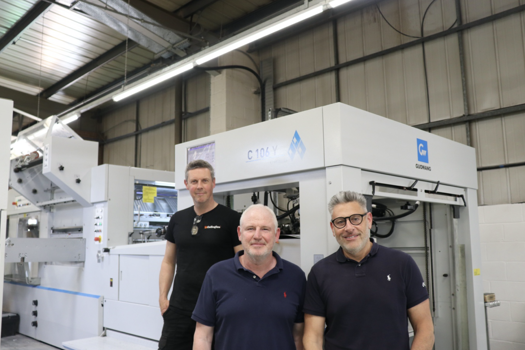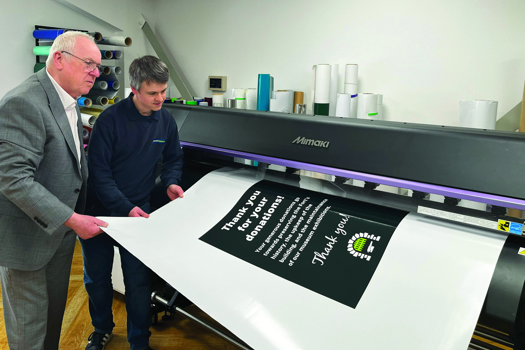For some businesses, 2019 might be their first taste of what festivals can offer, for more seasoned event-goers it’s the busiest time of the year and a large part of what they build their business on. For Matt Tydeman, founder and director at Imaginators, a wide- and superwide-format digital print production company based in Nazeing, festival season sees the firm hitting the road up and down the country. “We work on most of the festivals in the UK: Glastonbury, Reading and Leeds, Wireless... You name it,” he says.
“We provide stage branding, the visual element of what you look at on the stage and behind. We were a pre-press company originally, and we realised the market was shrinking and saw a market in digital.”
“We were lucky enough to work with an event sponsor and had the opportunity to produce some graphics for a stage. It was a great success and since then we’ve attracted business from every other music event in the country and now have a very strong reputation in the sector.”
Grafitec, supplier of used and reconditioned printing machines and bindery equipment, made the press back in June when it found itself in a field at the Glastonbury Festival installing a Stahl T52-4X to assist with the production of the event’s much sought-after daily newspaper. The job came about after the Festival team contacted them to buy a folder and the relationship developed from there,” explains Dan Harrison, sales and marketing manager.
“Our equipment was used for the production of the Glastonbury Free Press. This is the first time we’ve had the chance to work with a music festival, but it’s certainly not the first time we’ve gone well beyond our comfort zone in the interest of good printing. On this occasion we were only responsible for the machinery, but we offer support beyond the installation and train operators as well as helping with any technical issues beyond the initial install.”
Sheffield-based full-service print house, Northend Creative Print Solutions, works with a handful of arts and film events across the north of England and understands only too well the changeable world that events exist in. “Our clients include the Sheffield Doc/Fest, Children’s Media Conference and the Huddersfield Contemporary Music Festival who come back year after year as they want continuity and expertise,” explains account manager, Barry Vincent.
“We manage everything from inception to completion. Events can be quite demanding. They know what they want, and they have a short turnaround to get the finished product, so we always go the extra mile. We also understand the language, so when people from a film festival say ‘we have to go to print this afternoon, but I still don’t know what the opening film is so I can’t send you a picture yet’ you just go with it,” he says.
Having worked in the arts and film festival scene for so long, Northend is now winning events work through customer recommendations, a dream scenario.
“We hear the same thing over and over. People want things turned around very quickly, so we have to be flexible with what we can supply. If something is going to change, we tell them. It’s the old question of when do you want it and when do you need it? A lot of that isn’t about the end date; it’s about managing what happens before that. It’s pointless delivering a festival brochure days after the event has finished,” adds Vincent.
Above and beyond
Businesses that bag themselves a festival or event as a client should brace themselves to offer more than the usual print services. The team behind the Children’s Media Conference, a yearly event in Sheffield focused on the world of kids content, understand only too well the added benefits of a strong relationship with a printer. “From the large print jobs, such as the guide, to the smaller items in the lead-up to the conference, our printer is on speed dial. Many calls and texts are exchanged in order to ensure that the different print items are created and delivered on time,” stresses Jacqui Wells, deputy director at Children’s Media Conference.
After working in music events for two decades, Imaginators has developed a strong, and for many, enviable, reputation in the sector, winning numerous coveted awards. “Events are certainly high pressure with tight deadlines,” says Tydeman. “Digital print in large-format has evolved. We’ve got the cutting-edge technology which can produce the material very quickly and to a very high standard; we’re certainly producing a lot more than just print. When I sell our services, we’re a production company and we just happen to have six printing presses in the building. Clients are getting lots of knowledge.
“They’ve learned our talk and we’ve learned theirs. We understand the boundaries we can push and the finishing techniques that we can use. We’re part of the wider team that puts together the production for a music festival.”
Natalie Forrester, marketing director for the Manchester International Festival, believes that having a relationship with an array of printers with different specialisms works well and offers peace of mind. She says: “We use a range of printers: one for brochures and show programmes, another for leaflets and posters, and then ones for signage and venue dressing. The relationship between the event team and the printers is important.
“Our lead times can be very short, and we have many different variations of print job, and the quality of the print we need is very high. It’s key to have those relationships and a clear line of communication to make sure things can be delivered and installed on time and in time for shows opening and events happening. It’s so time-critical to what we do.”
Northend has picked up work from international filmmakers: “Through our work with Sheffield Doc/Fest we’ve worked with lots of filmmakers coming to Sheffield. If you’ve come from India or Canada, it’s pointless bringing a tube full of posters and materials. It can cost a fortune to carry it overseas. Instead, they contact us, send through their artwork and we create the required materials using either wide-format or digital print, and it’s ready for them to collect when they arrive in Sheffield,” says Vincent.
The Manchester International Festival is an event intended to bring together art and performance works from all around the creative sphere, and it needs printers who understand its unique genetics. “We’re working right to the wire. It’s important that the printers appreciate the nature of the festival, that they know what it’s like every two years, and they know what to expect and can work around it,” emphasises Forrester.
“They often offer advice on materials, particularly when it comes to installation, which in turn can reflect on the design. A lot of our shows take place in found spaces – this year we had a piece under the tunnels of Manchester Victoria Station – so when it comes to signage it can be quite challenging. The printers will come with us on-site visits and help us with questions, like how we can attach signage. We’ll take their advice and then our designers can come up with something that will suit the material. A lot of what they offer is technical advice on how to install things and answering questions like what sort of fork lift truck we might need.”
Long live festival marketing material
Up there with the iconic festival wristband, is the event programme or brochure that many people keep long after the event as a memento. As Harrison from Grafitec sums up, even in this digital saturated world, print still has a place. “Even with all of the technological developments in information delivery, people still enjoy a tangible product that they can hold and enjoy. As with the resurgence of music on vinyl records, print still holds a place in people’s hearts and offers a quality and experience that digital can’t replicate.”
“This is a discussion that we have had many times over the years when considering marketing and conference material for CMC,” explains Wells. “In an age of advertising bombardment, especially digitally, to have a physical object to look at and read can be more impactful. This is why the design is so important, because we are firm believers of only telling our customers what they need to know: time, date, place, cost, offer. So, the design has to be striking in order for the recipient to pick it up in the first place.”
For the first time this year, Manchester International Festival printed two editions of its main brochure, totalling a whopping 200,000 copies. “Whilst we’ve got a fantastic website and digital presence, the festival brochure is a vital source of information to Greater Manchester residents and people visiting the city. Since we did two editions, we were able push the brochures out to Liverpool, Leeds, Sheffield, York and Birmingham. We also did a big drop in London to encourage visitors. We distributed 25,000 copies of the brochure during the festival as well,” says Forrester.
“It’s so lovely looking around the city seeing people sitting back in their deckchairs and reading it; the brochure is really a part of the main festival experience.”
The Children’s Media Conference sees a bump in ticket sales after sending out direct marketing pieces: “When we go on sale three months before the conference, we mail out an announcement postcard to all those on our mailing list, and the sales impact is clear,”says Wells.
“Not only is it the chance for us to set the design theme for the year, but we can pinpoint the day the postcard hits doormats because the sales rise significantly. Last year’s design theme was so good that I have a print on my kitchen wall!”
For festivals and events offering themed content and shows, print enables them to produce bespoke material to target specialised groups. “Our themed leaflets mean we can group together all the dance shows or the art exhibitions. This allows us to target people specifically interested in those genres. We can get into dance studios and halls and reach people who wouldn’t normally come to our website. Print is still really massive for us, and it’s a great way of talking to our existing customers and reaching new audiences,” Forrester adds.
Advice on sustainability
Quite rightly, like most other businesses, festivals are very conscious of environmental impact. Print can play a key part in helping events reduce their carbon footprint.
An applaudable example of how the event/printer relationship can work is between Northend and the Children’s Media Conference. Vincent and the team suggested they use waste materials they wouldn’t usually have the budget to buy, and work this into the 2019 collateral.
“What we did this year for CMC looked great. We printed on left over material – so their announcement and reminder postcards and brochures had different covers on. Which looked great on social media. It worked well, protecting their messages of sustainability and also the designer’s idea of ‘things continuing,’” explains Vincent.
“We’ve innovated lots of new ideas for graphics to make things bigger, better and greener,” says Imaginators’ Tydeman. “Often things get reused as people become more conscious of being sustainable. We also offer storage facilities, so things are put away safely and then pulled out again next year. Sustainability is a big conversation for events.”










